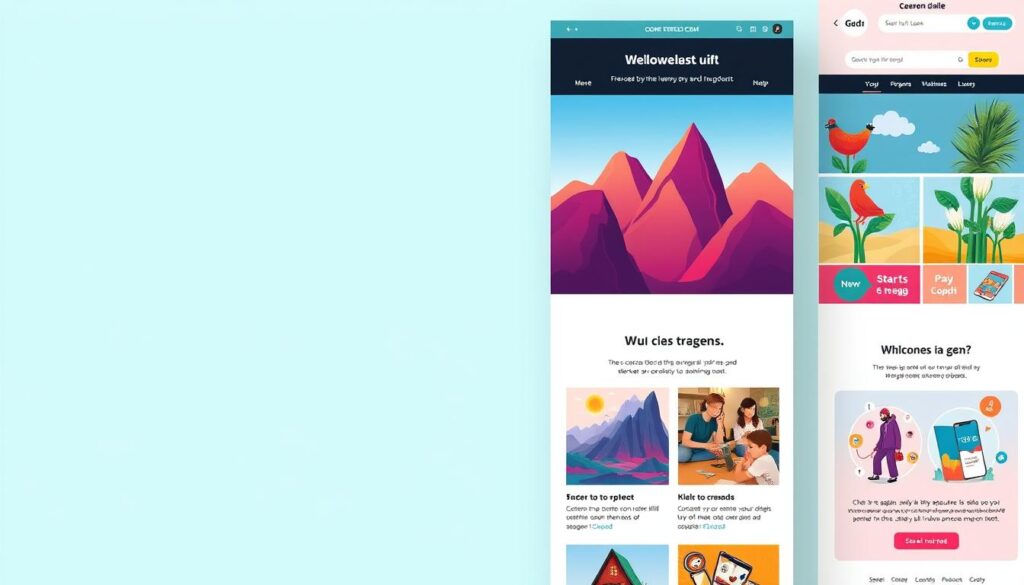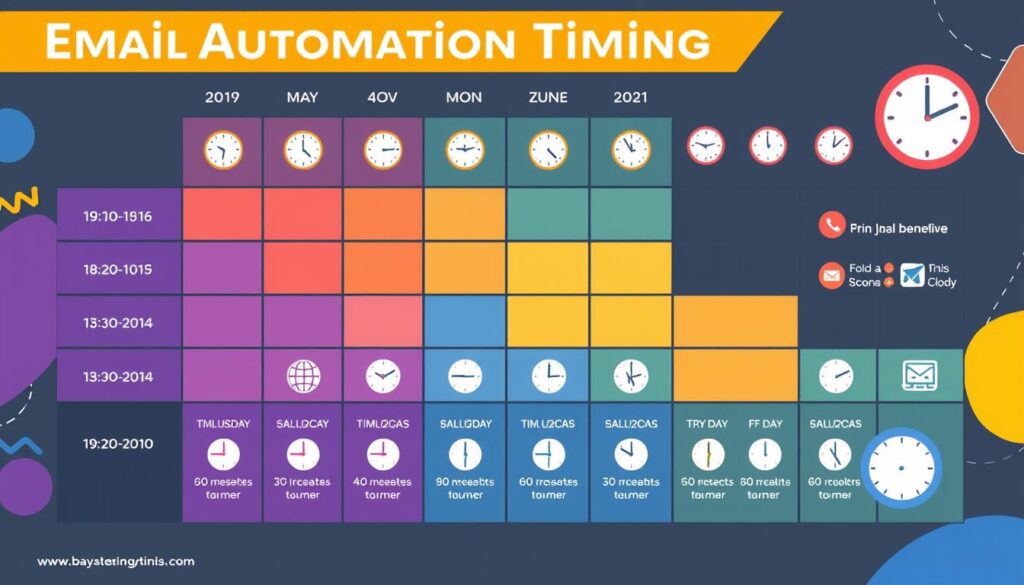I remember my first email campaign for my small business. The excitement of sending it out quickly turned to disappointment. Seeing low open and click-through rates felt like shouting into a void. That experience taught me the importance of mastering email marketing best practices.
Email marketing is still a powerful way to connect with customers. But, it needs finesse. Crafting compelling subject lines and personalizing content are key. Every element matters for your campaign’s success. Let’s explore how to make your emails stand out.
Effective email copywriting is about creating a connection. Using smart email list management and focusing on engagement can boost your rates. For example, personalized subject lines can increase open rates by up to 50%.
In this guide, I’ll share insights from years of trial and error, backed by industry data. We’ll cover segmentation strategies and the psychology behind calls-to-action. Whether you’re experienced or new, these tips will help you craft emails that engage your audience and drive results.
Key Takeaways
- Personalized subject lines can boost open rates by 50%
- Mobile optimization is crucial as most emails are opened on mobile devices
- A/B testing helps identify what resonates best with your audience
- Sending emails from a real person can increase open rates
- Include only one call-to-action per email to focus recipient attention
- Add alt text to images and buttons for improved accessibility
- Comply with GDPR and CAN-SPAM rules to avoid legal issues
Understanding Email Click-Through Rates (CTR)
Email metrics and analytics are key to measuring your email campaign’s success. The Click-Through Rate (CTR) is a crucial metric. It shows how well your content connects with your audience.
What is Email CTR?
Email CTR is the percentage of people who click on links in your email. It’s found by dividing the number of clicks by the number of emails sent. For instance, if 100 emails were sent and 5 people clicked, the CTR is 5%.
Why Email CTR Matters
CTR is important because it shows how engaged your audience is. A high CTR means your message and offers are appealing. Learning about these metrics helps improve your email marketing.
Average Email CTR Across Industries
CTRs differ by industry. Here are some averages:
- Education: 4% to 6%
- Healthcare: 3% to 5%
- Retail: 2% to 3%
- Nonprofits: 4% to 5%
The average CTR across industries is usually 2% to 5%. Triggered emails and autoresponders tend to have higher CTRs than regular newsletters.
- Use compelling visuals – campaigns with images have 42% higher CTRs
- Focus on a single, clear call-to-action
- Create scannable content for easy reading
- Implement good email hygiene practices to improve deliverability
By using these strategies and analyzing your email metrics, you can boost your CTRs. This will improve your email marketing results.
Crafting Compelling Subject Lines
Creating great subject lines is key to email success. The subject line is your first chance to grab attention. It can make or break your email’s success. So, I aim for clear, relevant, and valuable subject lines to boost open rates.
Subject lines should be short, around 50 characters or less. This makes them easy to see on mobiles, where most emails are opened. Using action verbs and creating urgency can also help a lot.
Personalizing emails is important. I include the recipient’s name in the subject line when I can. This has been shown to increase clicks. For example:
- “[Name], don’t miss our exclusive offer!”
- “Your personalized workout plan, [Name]”
A/B testing is a must for me to improve subject lines. By trying different versions, I find out what works best. I test things like:
- Subject line length
- Emoji use
- Questions vs. statements
- Personalization
Being clear is more important than being creative. I try to tell readers what to expect in the email. This approach has really helped my email marketing.
Email Marketing Best Practice: Personalization and Segmentation
Personalized email campaigns are changing the game in email marketing. With daily emails set to reach 400 billion by 2026, standing out is crucial. I’ve found that email personalization goes beyond using names. It’s about crafting messages that resonate with each recipient.
Tailoring Content to Recipient Preferences
I create content based on subscriber behaviors and interests. This approach has led to a 77% increase in email engagement for many marketers. By addressing recipients by name in subject lines, I’ve seen significant improvements in open rates.
Segmenting Your Email List
Segmentation is key to effective email campaigns. I divide my list into groups like:
- Email Enthusiasts: opened emails in the last week
- Silent Subscribers: never opened or purchased
- VIP Customers: frequent buyers with high lifetime value
This strategy has resulted in up to 760% revenue increase for some marketers.
Using Dynamic Content
I use dynamic content to show personalized product recommendations. This tactic, along with segmentation, has led to 30% more email opens and 50% more click-throughs. By tailoring messages to specific groups, I’ve reduced unsubscribes and kept subscribers engaged.
“Personalization makes customers feel valued, increasing the likelihood of clicks and purchases.”
With these practices, I’ve seen firsthand how personalized email campaigns boost engagement and conversions. Email marketing is a powerful tool in today’s digital landscape.
Optimizing Email Design for Engagement
Creating captivating email designs is key for successful email marketing. A well-designed email can greatly increase open rates and clicks. Let’s look at some best practices to improve your campaigns.
Start with a clean and simple layout. A design with plenty of white space makes your message clear. Use a single-column layout for better reading on all devices.
Visuals are important for keeping people engaged. High-quality images, videos, or GIFs can boost click-through rates. Always include ALT text for images for accessibility.
When writing your email, aim for concise and compelling content. Personalization is crucial – emails with personalized subject lines get opened 26% more often.
- Use clear, legible fonts
- Implement responsive design for mobile users
- Include visible and enticing CTAs
- Consider interactive elements like polls or quizzes
Finally, A/B test different design elements. This can improve engagement by 37%, helping you refine your strategy over time.
“Good design is good business.” – Thomas Watson Jr.
By following these design best practices, you’ll create more engaging campaigns. These campaigns will drive results and strengthen your connection with subscribers.
Creating Clear and Strong Calls-to-Action (CTAs)
Making effective CTAs is key to better email engagement. Even small tweaks in CTA design can boost conversion rates a lot. Let’s look at some top tips for creating CTAs that get results.
CTA Button Design Best Practices
When designing CTA buttons, make sure they’re easy to see. Use colors that contrast with the rest of the email. For mobile users, who open 44.7% of emails, make buttons big enough to tap easily, at least 44×44 pixels.
Placement and Wording of CTAs
Put your main CTA above the fold to grab attention right away. Use words that tell people what they’ll get by clicking. Short, direct text usually works better than long sentences. Adding a sense of urgency can also encourage people to act fast.
A/B Testing Your CTAs
Testing different CTAs is crucial to see what works best. Try out various designs, placements, and words to see what your audience likes most. Email analytics can show you which CTAs get the most clicks.
“Make the benefit of clicking on the CTA very clear to build trust with readers.”
Always match your CTA text with what’s on the landing page. This keeps things clear and avoids confusion. By following these tips and testing often, you can make CTAs that really work and boost your email success.
Leveraging Visual Content in Emails

Adding visuals to email marketing can really boost engagement. As an email copywriting expert, I’ve learned that visuals are crucial. Let’s dive into how to use visual content well.
Visual content in emails can be many things:
- High-quality images
- Infographics
- GIFs
- Videos
- QR codes
These elements quickly and clearly share messages. Marketers who use visual content see a 27% jump in click-through rates. This shows how visuals grab attention.
Video content is especially powerful. Studies show using video in emails can increase click-through rates. Just mentioning “video” in your subject line can raise open rates by up to 40%.
When adding visuals, keep these best practices in mind:
- Choose visuals that match your message and brand
- Make sure images load fast, especially on mobile
- Use visuals wisely to avoid overwhelming readers
- Test different visuals to see what works best
By using visual content well, you can make more engaging emails. Successful email copywriting is about more than words. It’s about creating a visually appealing experience that grabs your audience’s attention.
Mobile Optimization: A Key to Higher Click-Through Rates
In today’s digital world, making emails mobile-friendly is key to success. Over 60% of emails are opened on mobiles. So, making your emails work well on small screens is essential. I’ve seen how mobile optimization boosts click-through rates and campaign success.
Responsive Design Principles
Responsive design makes your emails look good on any device. I suggest using a single-column layout for easy reading. Also, keep subject lines under 50 characters and pre-header text under 100 characters. This helps a lot on mobile screens.
Mobile-Friendly Email Elements
To make emails mobile-friendly, focus on these elements:
- Large, tappable buttons (at least 44×44 pixels)
- Font sizes between 14-16 pixels for body text
- Plenty of white space to prevent accidental clicks
- Concise content that’s easy to skim
Testing Across Different Devices
Testing is a must in email marketing. I test my emails on different devices and email clients. This ensures they look good everywhere and fixes any issues before sending.
Remember, 70.46% of mobile users delete emails that don’t load properly within 2.8 seconds. Don’t let poor optimization cost you valuable engagement!
By using these mobile optimization tips, you’ll see better open rates, click-through rates, and overall campaign success.
Timing and Frequency: When to Send Your Emails
Sending emails at the right time is key for email success. Timing can greatly affect your campaign’s success. Studies show top cold email campaigns have open rates over 40%.

Weekends often see higher open rates than weekdays. Sunday leads with an 18.7% open rate. This might mean people have more time to check emails then. But, don’t ignore weekdays. Tuesday has a 13.4% open rate, making it a good choice for emails.
How often you send emails is also important. Sending emails regularly builds trust and boosts engagement. For cold emailing, sending weekly is often best. But, every audience is different. You need to test different times and watch your results.
“The key to successful email marketing lies in finding the perfect balance between timing and frequency.”
Don’t send too many emails or you might lose subscribers. Over-emailing can lead to more unsubscribes and spam. Segment your list by age, gender, and preferences. This way, you can send targeted emails without overwhelming people.
By adjusting your timing and frequency, you’ll make your email campaigns more effective. You’ll see better open rates and more clicks.
Conclusion: Implementing Best Practices for Improved Email Performance
I’ve looked into important email marketing tips to increase open and click-through rates. Email is still a big deal, with 87% of marketers saying it’s key for success. It also brings in $36 for every dollar spent, making it a top choice for ROI.
To make the most of email, focus on making it personal, mobile-friendly, and have clear calls to action. Always test and analyze your emails. With 44% of B2B marketers finding email the most effective, mastering these strategies can really help your business.
Email marketing is a continuous effort. Keep up with the latest trends, like using emojis in subject lines or adding interactive elements. By always using these best practices and understanding your audience, you’ll see lasting success in your email campaigns.
FAQ
What is email CTR?
Email CTR, or click-through rate, shows how many people click on links in an email. It’s found by dividing the number of clicks by the number of emails sent. This metric helps measure how well an email engages its audience.
Why is email CTR important?
Email CTR shows if people are interested in what you’re sending. A high CTR means your emails are grabbing attention and encouraging action. This is key for success in email marketing.
What are some best practices for crafting compelling subject lines?
For great subject lines, use action words and create a sense of urgency. Make it clear what’s in it for the reader. Adding the recipient’s name can help too. Keep it short and test different versions to see what works best.
How can I tailor email content to recipient preferences?
Personalize your emails by using what you know about the recipient. Show them products or offers that fit their interests. This makes your emails more relevant and engaging, leading to better results.
What are some best practices for email design?
Design your emails to look good on any device. Use a simple layout and clear fonts. Add visuals like images or videos to make it more interesting. Make sure the most important parts stand out.
How can I create clear and strong CTAs in emails?
Use clear language in your CTAs to tell people what to do. Make the buttons stand out with contrasting colors. Place them above the fold and test different designs to find what works best.
Why is visual content important in emails?
Visuals like images and videos can really grab attention. They help get your message across quickly. Videos, in particular, can increase clicks by a lot.
How can I optimize emails for mobile devices?
Use designs that work on all screen sizes. Keep it simple and short for mobile users. Test your emails on different devices to make sure they look good everywhere.
What are the best times and frequencies for sending emails?
Send emails between 10 a.m. and 2 p.m. for best results. But, test different times to see what works for your audience. Send emails regularly, but not too often. This keeps your audience engaged without getting overwhelmed.

